
When comparing inversion table vs spinal decompression, spinal decompression is the safer choice for at-home spine care. It’s non-invasive, gravity-neutral, and designed for long-term use. If you’re dealing with chronic back pain, choosing the right method matters, not just for relief, but for safety and sustainability.
Many people with spine issues want to manage pain without relying on medication or frequent clinic visits. That’s where at-home solutions come in. But not all tools are created equal. This article breaks down the differences between inversion tables and spinal decompression devices to help you decide which one fits your needs.
Spinal decompression gently stretches the spine to relieve pressure on discs and nerves. It’s used to treat herniated discs, sciatica, spinal stenosis, and chronic lower back pain. The goal is to create space between vertebrae, allowing nutrients to flow and inflammation to reduce.
At home, spinal decompression is done using a specialist-designed device. You lie flat on the floor or bed, and the device supports your spine while promoting natural alignment. There’s no inversion, no strain, and no need for assistance. It’s a passive, controlled process that works with your body.
This is one of the key differences in the inversion table vs spinal decompression debate: one method works with gravity, and the other works against it.
An inversion table tilts your body backward so your head is lower than your feet. The idea is that gravity helps stretch your spine, decompressing the vertebrae and relieving pressure. Some people use it for short-term relief after long hours of sitting or standing.
To use an inversion table, you strap yourself in, tilt backward, and hang at various angles. While this can feel relieving for some, it’s not suitable for everyone. The position increases pressure in your head, eyes, and cardiovascular system. It also requires physical strength and balance to operate safely.
| Feature | Inversion Table | Spinal Decompression |
|---|---|---|
| Body Position | Full-body inversion | Lying flat |
| Risk Level | Higher pressure on head and eyes | Gravity-neutral |
| Ease of Use | Requires strength and setup | Simple and stable |
| Space Needed | Bulky and hard to store | Compact and portable |
| Medical Backing | Mixed reviews | Often recommended by spine specialists |
The inversion table vs spinal decompression comparison shows clear safety advantages for spinal decompression. It’s easier to use, more comfortable, and better suited for long-term care.
Inversion tables aren’t for everyone. You should avoid them if you have:
Even if you’re generally healthy, inversion tables can be uncomfortable. You need to strap in, tilt slowly, and monitor your body’s reaction. That’s a lot to manage when you’re already in pain. For older adults or people with limited mobility, inversion tables can pose unnecessary risks.
This is another reason why the inversion table vs spinal decompression decision should be based on your health profile and comfort level.
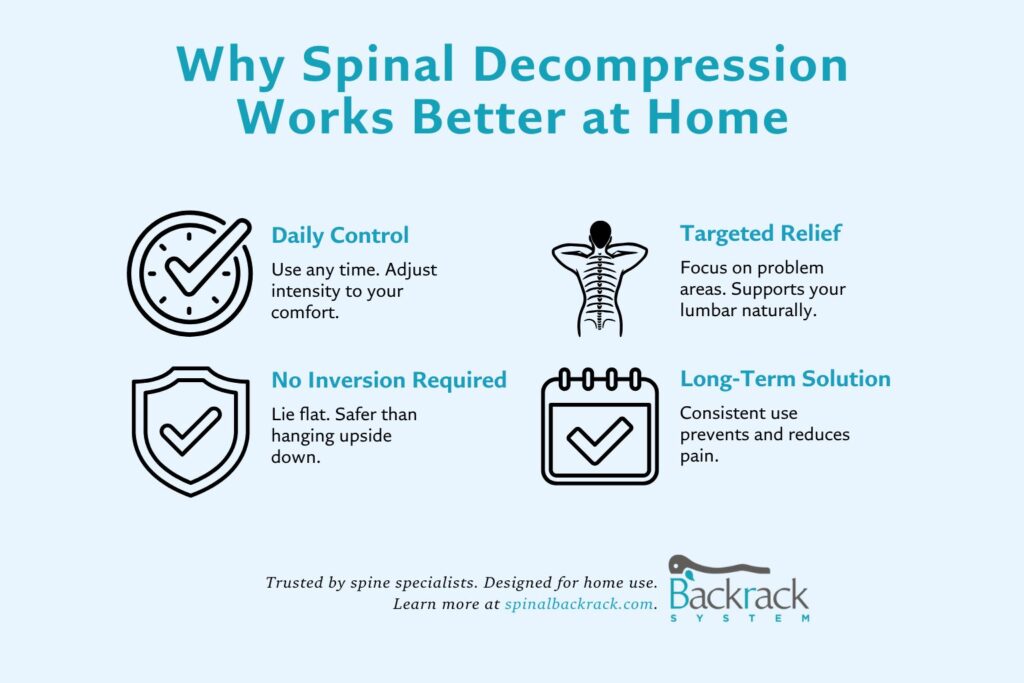
Spinal decompression gives you control. You can use it daily, adjust the intensity, and focus on the areas that hurt most. It’s designed for long-term use, not just quick relief.
You don’t need a spotter. You don’t need to flip upside down. You just lie down and let the device do the work. That’s why spinal decompression is safer for your spine at home.
It also fits into your routine. Whether you’re a desk-bound professional, an active adult with back stress, or someone managing chronic pain, spinal decompression can be part of your daily wellness plan. It’s quiet and simple and doesn’t require electricity or setup time.
Let’s talk numbers. Inversion tables range from $150 to $500. Spinal decompression devices vary too, but many are priced similarly. The difference is in the results.
Inversion tables offer temporary relief. Spinal decompression supports long-term healing. That means fewer clinic visits, fewer medications, and fewer flare-ups.
So while the upfront cost may be similar, spinal decompression saves you more over time. You’re investing in a tool that helps you recover, prevent future pain, and stay active without relying on drugs or appointments.
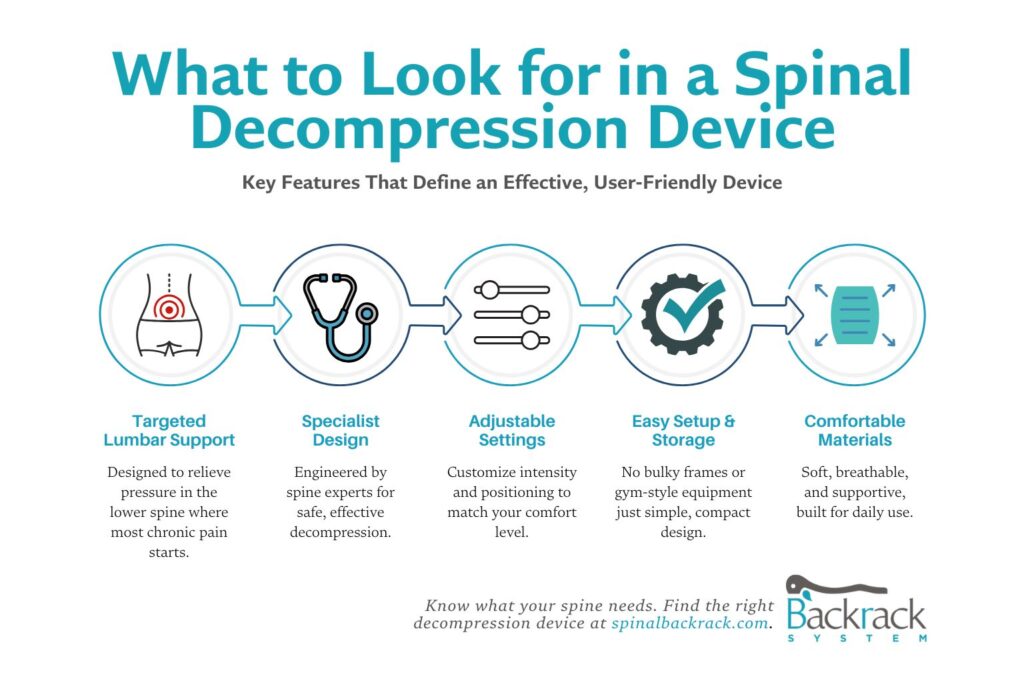
Not all spinal decompression tools are equal. Here’s what to look for:
Avoid anything that looks like a gym machine or requires complicated setup. You want simplicity and precision. When comparing inversion table vs spinal decompression, the right device makes all the difference.
People with chronic back pain say spinal decompression helps them sleep better, move more freely, and avoid painkillers. Desk workers use it to undo hours of sitting. Active adults use it to recover after workouts. Older users say it’s gentle and effective.
One user shared that after using spinal decompression daily for two weeks, they noticed less stiffness in the morning and fewer flare-ups during the day. Another said it helped them avoid surgery by managing herniated disc symptoms naturally.
These are the outcomes you want without the risks of inversion.
To get the most out of spinal decompression:
Consistency matters. Spinal decompression works best when it’s part of your routine—not just a one-time fix. It’s a safe way to care for your spine without the complications of inversion.
The inversion table vs spinal decompression debate often comes down to safety, ease of use, and long-term results. Spinal decompression is non-invasive, easy to use, and backed by specialists. It fits into your life without adding risk or complexity.
If you’re looking for a reliable way to manage back pain at home, spinal decompression is the better option. It helps you stay active, sleep better, and avoid unnecessary strain. That’s why spinal decompression wins the inversion table vs spinal decompression comparison every time.
Spinal decompression therapy is a non-invasive technique that gently stretches the spine to relieve pressure on compressed discs and nerves. This process helps improve circulation, reduce inflammation, and promote healing in the lumbar region. At-home devices allow users to control intensity and target specific pain areas without the need for inversion or bulky equipment.
Yes, spinal decompression can be safely done at home using a specialist-designed device. Look for features like targeted lumbar support, adjustable settings, and comfortable materials. Unlike inversion tables, these devices allow you to lie flat and decompress your spine without flipping upside down, making them safer for older adults and those with mobility concerns.
When choosing a spinal decompression device, prioritize targeted lumbar support, expert engineering, adjustable intensity, easy setup, and breathable materials. Avoid gym-style machines or devices that require complex assembly. A well-designed product should be compact, comfortable, and built for daily use.
Many users report noticeable relief within the first few sessions, especially when targeting chronic lower back pain. Consistent use over several weeks can lead to long-term improvements in mobility, posture, and pain reduction. Results vary depending on the severity of the condition and how regularly the therapy is used.
The Spinal Backrack is one of the most recommended devices for at-home spinal decompression. Designed by spine specialists, it targets the lumbar region without requiring inversion or electricity. Its compact, adjustable design makes it ideal for daily use, especially for those managing chronic back pain.
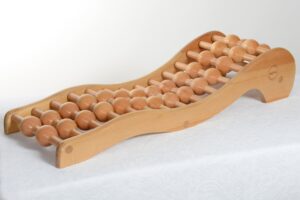
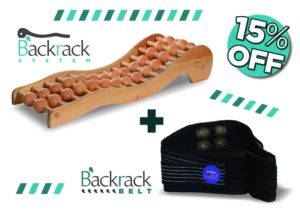

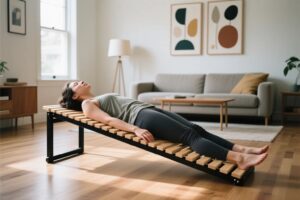


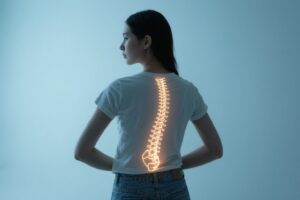

Sign up our newsletter to get article update about backrack therapy.